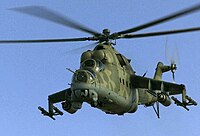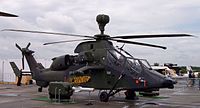Attack helicopter
An attack helicopter is a military helicopter specifically designed to carry weapons, dedicated primarily to ground targets such as infantry, armored vehicles, and buildings or structures. Attack helicopters can be equipped with automatic cannons, machine guns, rockets, and missiles like the AGM-114 Hellfire or the Spike ER. Many also have air-to-air missile capability, though usually as a self-protection measure. Currently, attack helicopters have two main tasks: firstly, to provide close, direct and precise air support to ground units and secondly, to destroy vehicles, armored or not. They are also used to complement lighter helicopters, such as the OH-58 Kiowa, on armed reconnaissance missions.
History
The concept of helicopter air support began informally during the Korean War and developed during the Algerian and Vietnam wars.[citation needed] Initially, this support was provided by utility helicopters modified to carry various weapons systems and known as helicopter gunships.
In the mid-1960s, during the Vietnam War, the US Army realized it needed a purpose-built attack helicopter with more speed and firepower than gunships. in force, due to the increase in the intensity of ground fire (usually using heavy machine guns and anti-tank rockets) by the troops of the Viet Cong and the Army of North Vietnam. Because of that need, and with the growing complication in Vietnam, the US Army developed the requirements for a pure attack helicopter with the AAFSS (Advanced Aerial Fire Support System) program. Advanced Aerial Fire). The aircraft design selected in 1965 for that program was Lockheed's AH-56 Cheyenne.
As the US Army began procurement of its pure attack helicopter, it was looking for options that would improve the performance of improvised aircraft still in use (such as the UH-1B/C). In late 1965, a group of high-level officers were chosen to evaluate various prototype versions of attack and armed helicopters to determine which provided the greatest increase in capabilities over the UH-1B. Three aircraft achieved the highest scores during the evaluation: the Sikorsky S-61, the Kaman H-2 Tomahawk and the Bell AH-1 Cobra were selected to compete in flight tests conducted by the Army's Aviation Test Activity. After completing flight evaluations, the Test Activity recommended Bell's Huey Cobra as the interim armed helicopter until the Cheyenne was fielded. On April 13, 1966, the Army awarded Bell Helicopter a contract to produce 110 AH-1G Cobra helicopters. The Cobra had a narrow fuselage to make the helicopter a smaller target, increased protection with armor, and high speed.
In 1967, the first AH-1Gs were deployed to Vietnam, around the same time the Cheyenne successfully completed its maiden flight and initial flight evaluations. As the Cheyenne program experienced some setbacks over the next few years due to technical problems, the AH-1 established itself as an effective air weapons platform, despite its performance shortcomings compared to the AH-56, and its own design flaws. By 1972, when the Cheyenne program was finally canceled to make way for the Advanced Attack Helicopter (AAH), the "provisional" it had already built a solid reputation as an attack helicopter.
After the Vietnam War, and especially in the 1990s, the missile-armed attack helicopter became a major anti-tank weapon. Able to move quickly across the battlefield and launch rapid strikes in which they can launch multiple missiles almost automatically, helicopters pose a great threat even in the presence of anti-aircraft defenses. The gunship became an important tool for both the US Army and its Warsaw Pact counterparts in tank warfare, with most attack helicopters becoming increasingly optimized for anti-tank missions. The United States Marine Corps continued to use the helicopters for close air support missions, with the AH-1 Cobra and AH-1 Super Cobra. The first Soviet attack helicopters, the Mil Mi-24, retained the ability to transport troops rather than just focus on the attack.
Although in the Middle East attack helicopters have more than demonstrated their capacity as destroyers of armored vehicles, they are currently being sought to be more versatile. Fixed-wing aircraft can be effective against tanks, but helicopters' unmatched ability to fly at low altitudes and low speeds make them well-suited for close air support. There were helicopters initially built for other tasks that were developed for special operations missions, such as the MH-6 for extremely close support.
The ability of attack helicopters to carry out 'deep attack' operations, conducted independently, was called into question after a failed mission during the attack on the Karbala gorge in the 2003 invasion of Iraq. However, a second mission in the same area, four days later, but coordinated with artillery and fixed-wing aircraft, was much more successful with minimal losses.
Modern Attack Helicopter
At the end of the 1970s, the United States Army felt the need for more sophistication within its attack helicopter corps, which would allow them to operate in all-weather conditions. To alleviate this need, the program "Advanced Attack Helicopter" (in English AAH or Advanced Attack Helicopter), in which the Hughes YAH-64 was the winner. The armed forces of the Soviet Union, fearful of the momentum that the attack helicopter was experiencing in the United States United, they also felt the need for a more advanced helicopter. For this, they asked the companies Kamov and Mil to design the most advanced helicopters. The contest was officially won by the Kamov Ka-50, but Mil decided to continue developing its original proposal, the Mil Mi-28. It is worth mentioning that the Ka-50 and Ka-52 are the only helicopters in the world that have an ejection seat.
The 1990s saw the consecration of the American attack helicopter concept. AH-64 Apaches were used extensively during Operation Desert Storm with great success. The Apaches were the first to fire in that war, destroying enemy early warning radar and surface-to-air missile sites with their Hellfire missiles.
Later on they were effectively used in their two main tasks, for direct attack against enemy armored vehicles and as air artillery in support of ground troops. Many enemy tanks were destroyed by Hellfire missiles and Apache helicopter cannons.
Today, the attack helicopter has been further refined, and the AH-64D Apache Longbow showcases many of the advanced technologies that are being considered for future helicopter deployment. The Russians are fielding the Ka-50, and Mi-28, which are roughly equivalent although these are not tied to a command and control system of a level that is fully comparable to current US equipment. Many analysts of ground attack helicopter warfare concluded that linking to a network was a requirement for today's modern militaries. Since then attack helicopters have been increasingly incorporated into most of the world's armies as part of a system of linked support elements.
Attack Helicopters
Models of attack helicopters according to their appearance:
Contenido relacionado
Bubble sort
Waveform Audio Format
ICab









